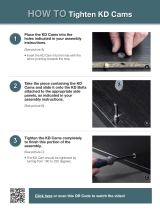
COMP Cams®
3406 Democrat Rd.
Memphis, TN 38118
Phone: (901) 795-2400 Fax: (901) 366-1807
www.compcams.com
8. Reinstall the cam sprocket temporarily. Check the timing mark alignment in your engine
manual. Rotate the crankshaft to its proper position. For instance, the Small Block Chevrolet
has a “dot over dot” alignment. Remove the camshaft sprocket and install the new COMP
Cams® timing chain. Next, bolt the cam sprocket to the camshaft. Make sure the sprocket is
pulled up flush onto the cam. Once again, be sure the timing marks are positioned properly and
according to the engine manual. Refer to your manual for the proper torque specifications
before tightening the camshaft bolt or bolts. COMP Cams® suggests that Loctite be applied to
the threads of the camshaft bolts to assure they remain torqued to the proper specification. This
process is very important! Warning: Improperly torqued camshaft bolts can loosen and
cause severe engine damage. A camshaft bolt locking plate (Part #4605) is recommended
for Chevy 262-400c.i. and 396-454c.i. engines.
9. Remove your new COMP Cams lifters from the packaging and clean the lifters thoroughly in
mineral spirits or an equivalent solvent. Remember, in order to protect your camshaft warranty,
new COMP Cams® lifters must be installed on flat tappet cams. It is not necessary to “pre-
pump” hydraulic lifters full of engine oil prior to installation and valve adjustment. It is actually
undesirable to do so as the “pumped up” lifters will cause the valves to open during the
adjustment process, rather than positioning the lifter plunger in its operating position as it is
supposed to do. “Pre-soaking” hydraulic lifters in a bath of engine oil is a good idea but not
mandatory. Doing so ensures that the lifters are adequately lubricated on their outer surfaces
prior to installation. It may also result in a quieter engine start up as the oil in the bath may
displace some air from the lifter’s plunger reservoir. Coat the bottoms of all flat tappet lifters
with COMP Cams Cam & Lifter Installation Lube (Part #103) supplied with the cam. Install
the lifters, making sure they fit well. Flat tappet lifters should rotate freely in the lifter bores.
Any excess clearance or tight lifters can cause damage to the camshaft, leading to engine
failure. Note: .0015”-.002” lifter bore clearance is minimum.
10. Clean all pushrods thoroughly because most engines oil through the center of them. If the
original pushrods are being used, be especially sure they are clean inside and out. Apply a small
amount of COMP Cams® Engine Assembly Lube (Part #102) or equivalent lube on each end
of the pushrods and install them into the engine. Clean all rocker arms thoroughly. If the
original rocker arms are used, examine each one for excessive wear and replace any that are
questionable. Apply a small amount of lube on all contact areas of the rocker arm. With a clean
rag or towel, wipe the tips of the valves clean and apply lube to them where the rocker arms
will come in contact with them. Also be sure to check the valve stem tips for excessive wear.
11. Install rocker arms. Do not tighten the adjusting nuts down before the proper sequence is
performed. On engines with shaft mounted adjustable rocker arms, back off all adjusters
completely before installing the assembly. Make sure the pushrod is in the lifter and the rocker
arm seat when making valve adjustments.
Hydraulic Flat Tappet and Hydraulic Roller Camshafts: First turn the engine in the normal
direction of rotation. Start with cylinder number one (1). When the exhaust valve begins to
move, adjust the intake valve to zero lash plus an additional ½ turn more. Rotate the engine
over again until the intake valve reaches maximum lift and is almost all the way back down.
Then set the exhaust valve to zero lash plus ½ turn. Adjust the valves on each cylinder in this
















